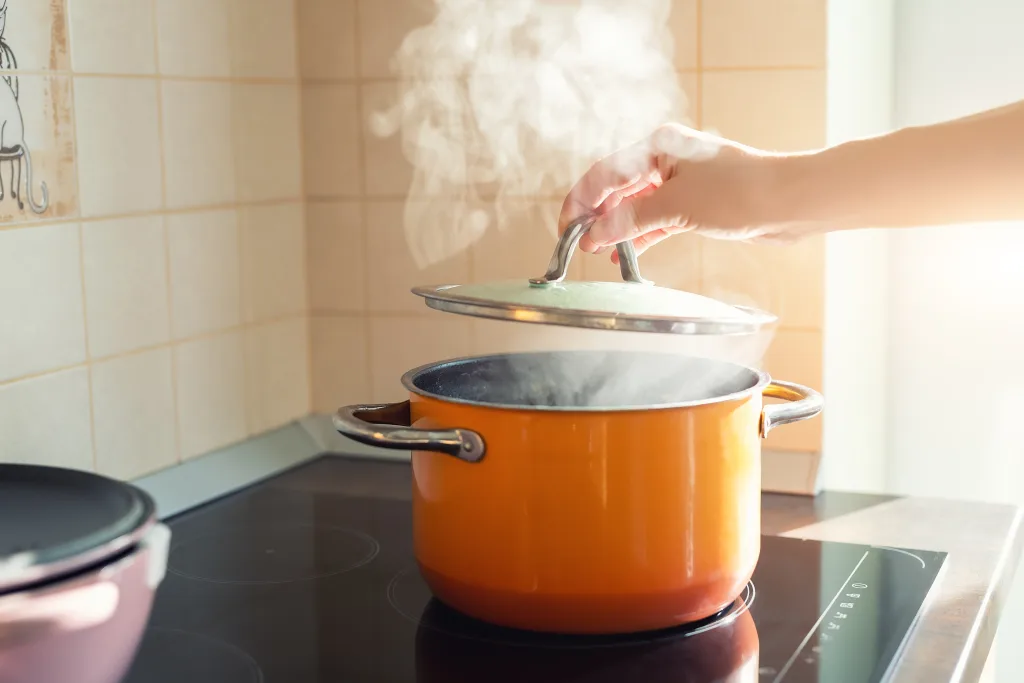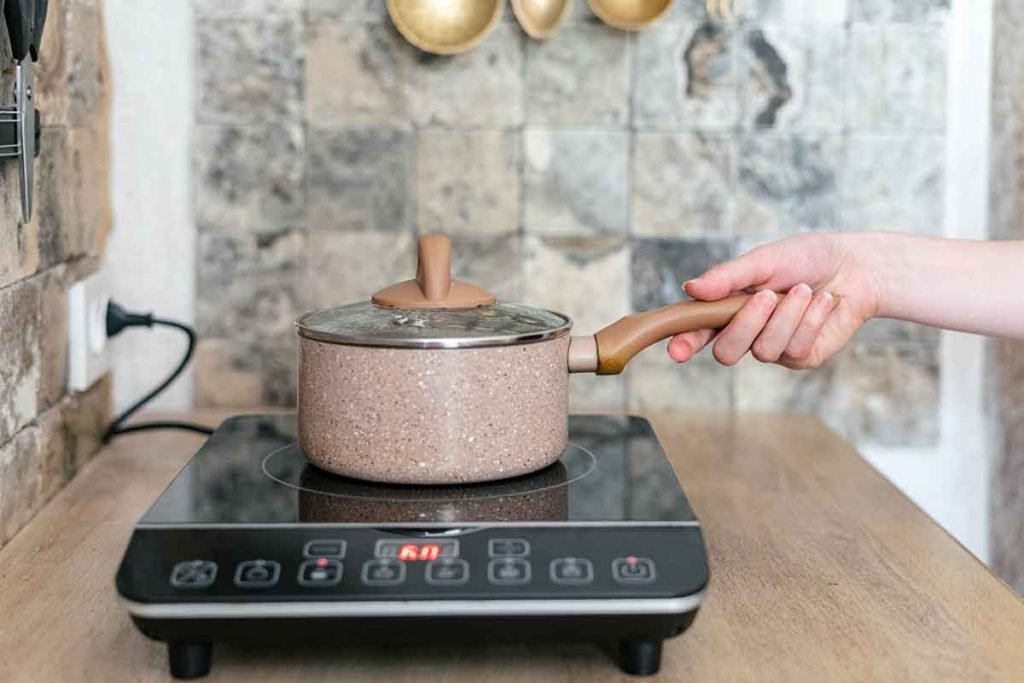Rice is a staple on my family’s menu—meaning I have cooked a ton of rice over the years. During this time, I have carefully honed the ability to turn out pots of perfectly fluffy and tender rice on demand. While constant practice and a keen culinary interest help, my beloved induction cooktop is the secret ingredient in my rice-cooking prowess.
You can take this to the bank—cooking rice on an induction cooktop gives you a Midas touch. It allows me to turn out perfectly cooked dishes that won over my harshest critics—aged 5 and 9—and gets them asking for seconds.
Dig in as I detail my rice cooking process on the induction cooktop, step-by-step.
Step by Step of Cooking Rice With an Induction Stove
Ingredients
- Rice – white, brown, wild,
- Water or broth
- Garlic, minced
- Diced onions
- Spices – curry powder, cumin, red pepper flakes or paprika
- Olive oil
- Water, vegetable, or chicken broth
Equipment
- Induction Cooktop
- Pot with a lid
- Measuring cup
- A rice paddle or wooden spoon
Step 1: Measuring Out the Rice
When cooking rice on an induction cooktop, you must be precise with your measurement—it guarantees excellent results. My go-to ratio is 2 cups of water for every cup of rice.
Step 2: Rinse the Rice
While this step is optional, I always rinse my rice primarily because it feels hygienic, but there’s culinary value in it as well. Rinsing the rice helps remove the excess starch and keeps it from becoming too sticky. Place the rice in a fine-mesh strainer or colander and rinse under cold running water until the water runs clear.
Step 3: Sautee the Onions and Garlic
Set your induction cooktop to medium heat and heat the oil in an induction-compatible cookware. Add the onions, garlic, and your preferred condiments. Cook the onions until they’re tender and translucent. I like adding in the rice at this step to infuse more flavor.
Step 4: Add Your Liquid of Choice
After sauteing my aromatics, I measure the water or broth into the saucepan with rice and bring it to a rapid boil over high heat. I prefer cooking white rice at around 200-212°F (93-100°C). I’ll lower the temperature for brown rice as it takes longer to cook.
While some prefer boiling the water before adding the rice, I always cook my rice from cold water. Starting the process with cold water enables the rice to absorb the water and cook evenly. When you add water to the boiling water, the intense heat may cook the outer layers too quickly and make your rice sticky.
Step 5: Bring the Pot to a Boil
You can turn up the heat and bring the water or broth to a rapid boil. With an induction cooktop, you can turn the temperature to the highest setting until the water boils. If that to an incredible time-saving hack when pressed for time.
Step 6: Simmer Until Tender
Turn the heat low once the pot starts boiling, cover it with a tight-fitting lid, and let it simmer. Simmering prevents the rice from boiling over and ensures the rice cooks evenly.
I usually leave the rice to simmer for 15 to 20 minutes, which is the time it takes to tenderize and absorb all the liquid. Brown rice cooks twice as long, which may take 40 to 45 minutes.
With induction cooktops, there’s no need to wait for the rice to cook. I simply set the cooking duration and leave it be. The stovetop will go off and alert me when the rice is done cooking. An auto-shut-off is part of an induction cooktop’s safety features.
Turn off the Heat
Since the heat goes off immediately when you turn off the cooktop, you can leave the pot on the hob. Once the cooking time is up, and the induction cooktop turns off, let the rice sit covered for 5 to 10 minutes. This resting period is crucial. It allows the rice to finish steaming and become tender.
Fluff the Rice
After resting, remove the lid and gently fluff the rice with a rice paddle or a wooden spoon. Use the rice paddle to scoop rice from the bottom of the pan and turn it over. Fluffing helps separate the grains and prevents the formation of clumps, improving the rice’s texture.
Serve and Enjoy
Your rice is now ready for serving as a side dish or base for various recipes. Enjoy!
Rice Water Ratio and Cooking Times
This one is quite a challenge to many. How much water do you add to your rice? How long should you cook the rice? Whether you are using an induction stove or any cooktop, here are some quick guidelines you should follow:
Should You Rinse the Rice Before Cooking It?
Yes, you should always rinse your rice before cooking it. As with any grain, rinsing the rice serves one primary reason—cleanliness. Washing the rice helps remove all the stuff you don’t want getting into your mouth—dirt, debris, dust, bugs, and chemicals.
For fun, I like checking the packaging to see where my rice comes from; most rice comes from Asia. Now that’s quite a journey to your local supermarket. Now imagine what the rice may have picked up during its voyage and storage (usually in gunny bags) before it was attractively repackaged in its current package.
Besides maintaining high hygiene levels, rinsing my rice has great culinary benefits, including:
- Removing excess starch: Rinsing the rice removes the excess starch adhering to the grains’ surface, which will likely make the cooked rice sticky.
- Improved texture: Rinsing the rice may give the cooked rice a firmer texture, which is preferable in some dishes.
- Prevents clumping: By removing the excess starch that may cause the cooked rice to become sticky, rinsing prevents clumping, which makes the cooked dish more appealing.
However, I don’t rinse my rice when making specialty dishes such as pasta risotto. For this, I use specialty rice such as Arborio, Vialone, Canoroli, Nano, or Baldo, which benefit from having a starchy coating. Washing these premium rice brands would ruin the creamy texture that gives the dish its signature look.
How is the Induction Hob Different when Cooking Rice?
An induction hob offers a distinctive cooking experience compared to the conventional gas or electric cooktop. You’ll never go back once you’ve made the switch. My induction stovetop is my go-to cooking appliance. My gas cooker is more of a backup in case the lights go out.
You’ll love the efficiency and convenience of cooking rice on an induction Hob. Since induction stovetops use electromagnetic induction to heat the cookware directly, they facilitate up to 90% heat transfer. Standard gas cookers lose almost 50% of their heat. That means your water will boil faster when cooking rice.
You can set the cooktop to the optimum rice cooking temperature thanks to granular temperature controls. Once an induction hob achieves the desired temperature, it stays there until you change or switch it off. That gives you precise cooking temperatures, reducing the risk of over or undercooking your rice.
Thanks to its precise control, there’s zero risk of burning your rice when using an induction cooktop. Unlike a standard electric burner which stays hot for a while, the hob goes off immediately after you turn it off. You can safely leave the rice resting on the cooktop without the risk of burning.
Wrapping Up
An induction cooktop lets you turn out a perfect rice dish every time. Whether you’re cooking plain rice, spicing it with some aromatic, or going over the top with exotic rice varieties, you’re guaranteed exceptional results. An induction cooktop allows you to customize the cooking process to each rice variety without breaking a sweat.
Frequently Asked Questions
Can I Cook Rice on an Induction Cooktop?
Yes, induction cooktops are a great option for cooking rice. Their precise temperature control helps achieve perfect rice texture and doneness.
What Type of Pot Should I Use?
Opt for a heavy-based pot or rice cooker specifically designed for induction. Flat bottoms ensure even contact and heat distribution.
What Type of Rice Can I Cook?
You can cook many varieties like white, brown, jasmine, basmati, and more. Just adjust cooking times and water amounts based on the type.
What’s the Basic Rice-to-Water Ratio?
The standard water ratio for white rice is 2 cups of water to 1 cup of rice. Brown rice may need slightly more liquid – check packaging instructions.
Should I Soak the Rice Before Cooking?
Soaking rice beforehand is optional, but can help improve texture. 30 minutes of soaking time is typically sufficient.
Do I Need to Stir the Rice While Cooking?
Avoid stirring the rice frequently while cooking, as this can disrupt even cooking and cause stickiness.
How Do I Know When the Rice is Done?
Check the packaging for estimated cook times. White rice takes 15–20 minutes usually, while brown rice may require 40–50 minutes, until liquid is absorbed.
What if the Rice is Undercooked or Overcooked?
If rice is undercooked, add a bit of hot water to finish. If overcooked, spread on a sheet to dry and evaporate excess moisture.
Should I Let the Rice Rest After Cooking?
Letting cooked rice rest for a few minutes with the lid on allows steam to further fluff and tenderize the grains.
Can I Use the Induction Cooktop’s Simmer Function?
Use the induction cooktop’s simmer function to maintain a gentle simmer when cooking rice for best results.





